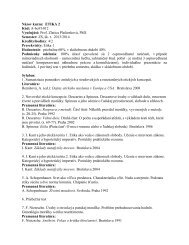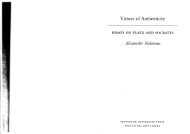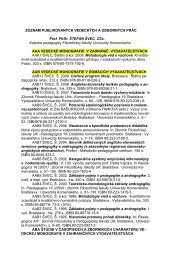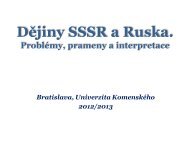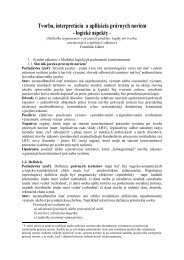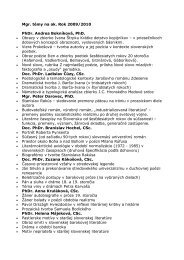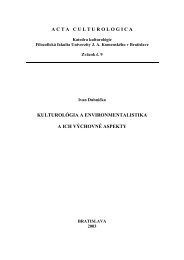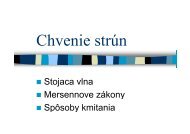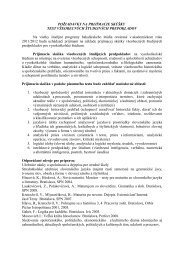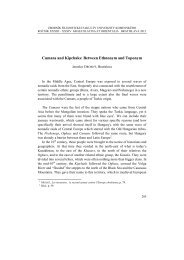You also want an ePaper? Increase the reach of your titles
YUMPU automatically turns print PDFs into web optimized ePapers that Google loves.
120 LEXICAL MEA I G<br />
not tall<br />
----------~--------~<br />
~ _ ~<br />
short tall<br />
Figure 6.3 Height scale (preliminary version)<br />
Gordon is short becau e he could have an unremarkable height in lead. Thu tall<br />
<strong>and</strong> short con titute a contrary pair. Some author (e.g. Lyon 1977, Cru e 1986)<br />
re erve the name antonym for preci ely thi type of scalar (or gradable) contrary<br />
relation.<br />
Cornplementary (alo cali ed contradictory) antonym are tho e for which<br />
the assertion of one entails the negation of the other <strong>and</strong> vice versa, a in (17).<br />
(17) a.<br />
b.<br />
That integer i even. ~ That integer i not odd.<br />
That integer is not odd. ~ That integer i even.<br />
In other word, the en e of complementary antonym completely bi ect some<br />
domain: every integer is either odd or even; there is no midd1e ground.<br />
ot all adjectival antonyms fit o nicely into the e categories. So-called gradable<br />
complementaries, like dishonest/honest, lie between complementarity <strong>and</strong><br />
contrariety. They seem to contradict each other (X is not honest entaii X is<br />
dishonest, <strong>and</strong> vice versa), but a middle ground seem to exi t, ince we can<br />
a sert that ome person is neither honest nor dishonest. Even cla ic examples<br />
of complementarity, like dead/alive, sometimes take on gradable qualitie (e.g.<br />
he 's more dead than alive).<br />
Cont.rariety <strong>and</strong> complementarity are of ten discussed with reference to adjectives<br />
( ee also chapter ll), although we can find contrary <strong>and</strong> complementary<br />
antonym in other part of speech. For example, Love/hale (noun or verb) are<br />
contrarie ,wherea the verb stay/go are in a complementary relation.<br />
Converse antonym describe the same relation or activity from different perspectives,<br />
<strong>and</strong> follow pattern like: if X i p to Y, then Y i q to X. Sometime<br />
one need to make adju tments to thi te t pattern in order to form a grarnrnatical<br />
sentence, a the examples in (18) how. For example ince Bill (X) i a parent<br />
(P) to Madeline (Y), Madeline (Y) i a child (q) of Bill' (X). In other word,<br />
Bill <strong>and</strong> Madeline have. a <strong>relations</strong>hip, <strong>and</strong> Bilľs position in the <strong>relations</strong>hip is<br />
parent, <strong>and</strong> Madeline' i child.<br />
(18) a.<br />
b.<br />
c.<br />
Bill i Madeline's parent. ~ Madeline is Bilľs child.<br />
John gives to Oxfam. ~ Oxfam receives from John.<br />
Scotl<strong>and</strong> i above Engl<strong>and</strong>. ~ Engl<strong>and</strong> is below Scotl<strong>and</strong>.<br />
Reversíve oppo ite involve the undoing of some action: tie/untie, con truction/demolition.<br />
Conver e <strong>and</strong> rever ive antonym can be collected, along with<br />
other mi cellaneou example (e.g. come/go), in a general category of directional<br />
antonyms.<br />
Some word pairs that an<br />
categorie . For example, le<br />
but they are not different p<br />
that typically co-occur. (1<br />
semantics to the tudents<br />
Other pairs of word that<br />
minirnally different (they a<br />
in being alcoholic/non-alo<br />
the e to be proper antonyn<br />
entailment relation like c<br />
Some of these types of al<br />
ness are nece sarily binary<br />
or a relation with two per p<br />
more generally in larger cr<br />
ha to be adapted to allow<br />
(19):<br />
(19) a.<br />
b.<br />
That ace i a clul<br />
That ace i not a<br />
Determine whether the follo<br />
converse, or no ne of these. E<br />
a. fast/slow<br />
b. student/teacher<br />
c. clean/dirty<br />
d. female/male<br />
e. [eminine/masculu<br />
Is antonymy a<br />
Finally, there i the que ti<br />
emantic relation or al o a I<br />
of the word are relevant la<br />
to be particularly <strong>lexical</strong>, Il<br />
hould not make much diff<br />
But a k anyone what the or<br />
intuition is backed up by th<br />
but large <strong>and</strong> Little do not (<br />
for in tance, dead/alive ee<br />
seems "better" than rise/des.<br />
ju t meaning may come intr




